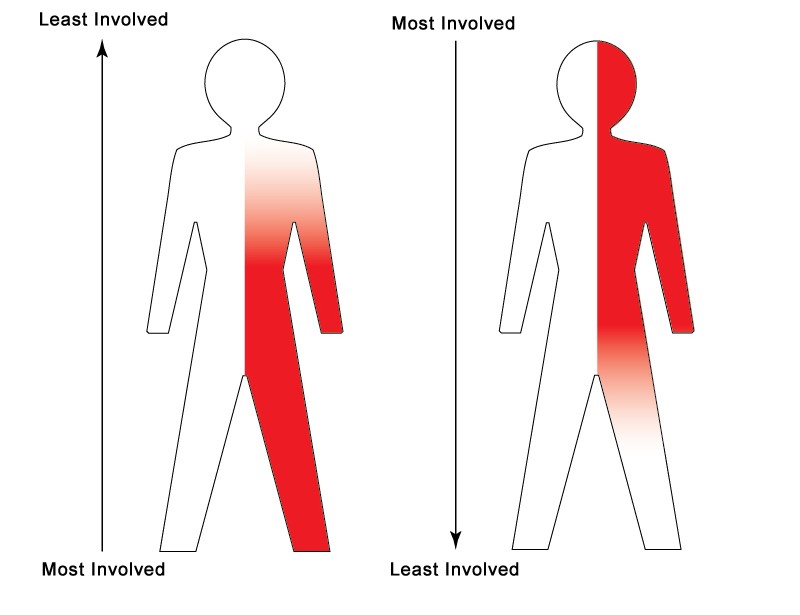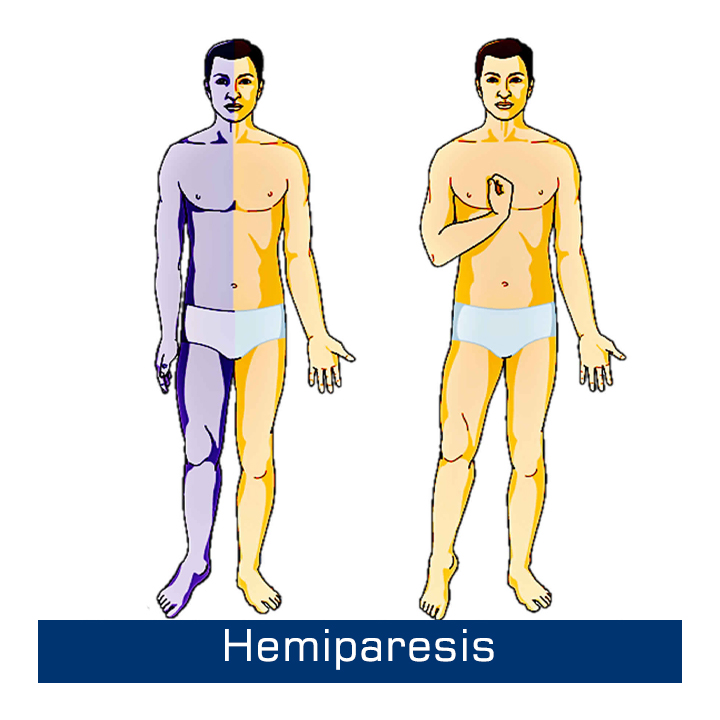Hemiplegia is a neurological condition characterized by paralysis on one side of the body, typically affecting the arm, leg, and sometimes the facial muscles. It results from damage to the brain or spinal cord, most commonly due to a stroke, but it can also be caused by traumatic brain injury, brain tumors, infections, or conditions like cerebral palsy. The severity of hemiplegia can vary, with some individuals experiencing complete paralysis and others having partial loss of movement and muscle control. This condition often leads to difficulties with mobility, coordination, and daily activities, and may be accompanied by other issues such as speech or cognitive impairments if the brain’s affected areas are involved. Treatment usually involves physical therapy, occupational therapy, medications, and, in some cases, surgical interventions to help manage symptoms and improve quality of life.

Hemiplegia causes :
Hemiplegia can be caused by a variety of conditions that result in damage to the brain or spinal cord. The most common cause is a stroke, which occurs when the blood supply to part of the brain is disrupted, either by a blockage or a hemorrhage, leading to the death of brain cells that control movement on one side of the body. Traumatic brain injuries, such as those from accidents or falls, can also cause hemiplegia if they affect the areas of the brain responsible for motor function. In children, hemiplegia is often associated with cerebral palsy, a condition resulting from brain damage before, during, or shortly after birth. Other potential causes include brain tumors, which can press on or damage motor-control regions, and infections like encephalitis or meningitis that lead to brain inflammation. Diseases such as multiple sclerosis may also result in hemiplegia due to nerve damage. Additionally, ruptured brain aneurysms or complications from brain surgery can sometimes lead to paralysis on one side of the body.
- 1. Stroke
- The most common cause of hemiplegia.
- Occurs when blood flow to a part of the brain is blocked or a blood vessel bursts, damaging brain tissue that controls movement.
- 2. Traumatic Brain Injury (TBI)
- Injury from accidents, falls, or violence can damage areas of the brain responsible for motor control.
- 3. Cerebral Palsy
- A congenital condition that affects movement and muscle tone, often caused by brain damage before or during birth. Hemiplegia can be a type of cerebral palsy.
- 4. Brain Tumors
- Tumors in the brain can press on areas that control movement, leading to weakness or paralysis on one side.
- 5. Infections
- Brain infections like encephalitis or meningitis can cause inflammation and damage, resulting in hemiplegia.
- 6. Multiple Sclerosis (MS)
- A chronic disease that damages the protective covering of nerves, possibly affecting motor control and causing partial or full paralysis.
- 7. Aneurysm or Hemorrhage
- A ruptured blood vessel in the brain (hemorrhagic stroke) can lead to sudden hemiplegia.
- 8. Brain Surgery or Complications
- In rare cases, complications from brain surgery can affect one side of the body.
Symptoms:
- Loss of motor control on one side
- Muscle stiffness or spasticity
- Trouble with balance and coordination
- Possible speech and cognitive issues if the brain is affected

Solutions for Hemiplegia:
There is no single cure for hemiplegia, but with the right combination of treatments and therapies, many individuals can significantly improve their movement, strength, and independence. The main goal of treatment is to manage symptoms, restore function, and prevent complications. Physical therapy is essential and focuses on improving mobility, muscle strength, balance, and coordination through targeted exercises. Occupational therapy helps patients relearn daily tasks such as dressing, eating, or writing, and often includes adaptive techniques or tools. Speech and language therapy may be needed if speech, swallowing, or communication is affected. Medications, such as muscle relaxants or anti-spasticity drugs, can help manage stiffness or involuntary movements. In some cases, surgical interventions like tendon release or nerve surgeries may be considered. Psychological support or counseling is also important, as dealing with hemiplegia can lead to emotional or mental health challenges. Early and consistent rehabilitation offers the best outcomes, especially when tailored to the individual’s specific needs and abilities.
Physical Therapy
- Improves strength, balance, and coordination
- Focuses on regaining movement on the affected side
Occupational Therapy
- Helps relearn daily activities (e.g., dressing, cooking)
- Uses adaptive tools and techniques for independence
Speech and Language Therapy
- Treats speech, language, and swallowing difficulties
- Improves communication skills if affected
Medications
- Muscle relaxants to reduce spasticity
- Pain relievers or nerve medications as needed
Assistive Devices
- Braces, canes, or wheelchairs to aid mobility
- Specialized equipment for home or work
Surgical Treatment (in some cases)
- Tendon release or nerve surgery
- Helps improve limb function or reduce spasticity
Psychological Support
- Counseling or therapy to manage depression or anxiety
- Support groups for emotional well-being
Home Modifications
- Installing ramps, grab bars, or stairlifts
- Making the environment safer and more accessible
Consistent Rehabilitation
- Long-term therapy and monitoring
- Personalized recovery plans for best results
